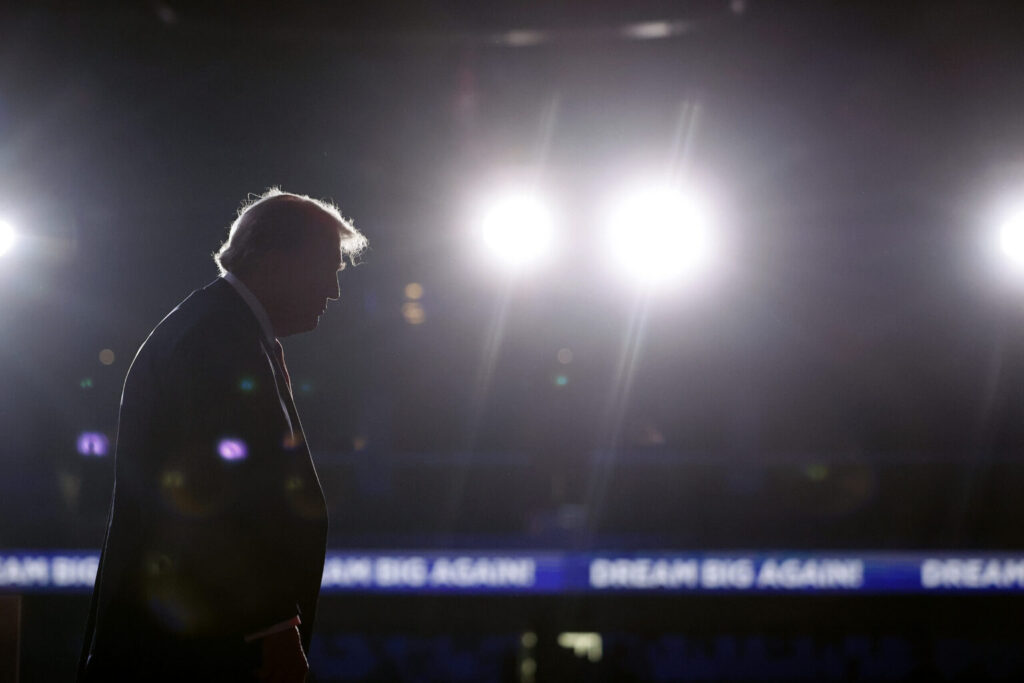
HENDERSON, NEVADA – OCTOBER 31: Republican presidential nominee, former President Donald Trump walks off stage at the end of a campaign rally at Lee’s Family Forum on October 31, 2024 in Henderson, Nevada. With less than a week until Election Day, Trump is campaigning for re-election on Thursday in New Mexico and the battleground states of Nevada and Arizona. Photo by Chip Somodevilla/Getty Images.
Welcome to The Topline, a weekly roundup of the big numbers driving the Minnesota news cycle, as well as the smaller ones that you might have missed. This week: the Twin Cities exception; Klobuchar overperformance; polarization in Minnesota; and the state of school levies.
Trump makes only modest gains in Twin Cities
One of the most striking developments in the 2024 election has been Donald Trump’s dramatic overperformance in deeply liberal urban areas. The Republican convicted felon and election denier ran up his previous margins by 5 points in Philadelphia, 9 points in Detroit, 11 points in Chicago, and around 20 points across much of New York City and Miami.
The how and why of that shift is still being sussed out, and is likely to be a source of contention among Democrats trying to figure out how to move forward. Part of the answer may lie in the urban areas that did not see such a big shift to the right, including the Twin Cities: How and why are they different?
Trump increased his margin by just 2 points in Ramsey County, and only 1 point in Hennepin County. Why was the shift there so much smaller? Was it because Gov. Tim Walz was on the ticket? Or because of fundamental demographic differences between places like the Twin Cities and those like New York? Were Democrats in Minnesota more energized to vote on account of the big progressive victories in the state Legislature in 2023? Despite all the publicity around crime and homelessness in the Twin Cities, are its residents more sanguine about Democratic governance than in those other big cities?
To be clear, the overarching dynamics in the Twin Cities are the same as elsewhere: lower turnout and a shift toward the GOP. But the magnitude of those changes is much smaller. Understanding why may help Democrats and progressives understand what they need to do differently in 2026 and beyond.
Klobuchar dramatically outperforms Harris
Another point of contrast between Minnesota and everywhere else: Sen. Amy Klobuchar ran an impressive 5 percentage points better than Kamala Harris, a bigger overperformance than any other Democratic Senator, with the exception of Montana’s Jon Tester, who lost.
Klobuchar won 21 of Minnesota’s 87 counties on her way to a 16-point victory over challenger Royce White. Harris, by contrast, took just 9 counties.
Part of that gap may be because Klobuchar had the benefit of a uniquely weak opponent with a short resume and a long history of bigoted remarks and scandals. On the other hand, the same could be said for Harris.
Still, Klobuchar’s 16-point margin was narrower than her three previous Senate victories, which all yielded margins of 20 points or more. Even more telling, in 2012, she won 85 of 87 counties. It’s a reminder of the power of political polarization, which helps even the least qualified candidates rack up impressive vote totals, provided they appear on the ballot with the right letter after their name.
Speaking of polarization
Last week the Star Tribune published a fantastic visualization of how Minnesota’s counties have split apart on partisan lines over the past decades. Places that were once relatively close to the political center have drifted toward the margins, with the populous Twin Cities counties heading left and the less populated rural regions moving right.
A cluster of mostly suburban counties still hover on either side of the center, and it’s no accident that those areas comprise many of the key battlegrounds in the state Legislature.
One interesting bit of ephemera in the data: Clay County, where Moorhead is located, had voted for the eventual winner of every presidential contest between 1992 and 2020. But voters there broke that streak this year, supporting the Harris-Walz ticket by the narrowest of margins.
Half of school funding levies succeed
MPR News reports that about half of the local school levies on the ballot this year succeeded. Generally speaking voters were more willing to renew existing funding, rather than raise new spending.
Earlier this year the Reformer reported on the dire school funding situation in the northwest Minnesota town of Thief River Falls, where elementary students were fundraising to save their own classrooms after voters rejected two back-to-back levies.
The school put a more modest levy before voters this year, which finally succeeded.

